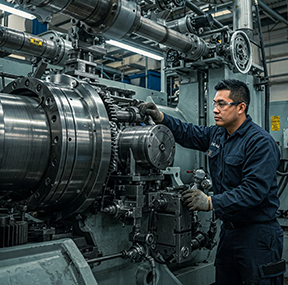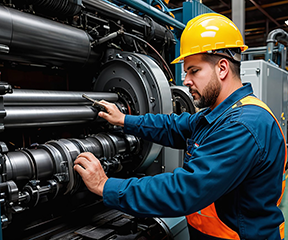Published: May 19, 2025 | Updated: October 22, 2025
Published: May 19, 2025 | Updated: October 22, 2025
Understanding Machine Maintenance Best Practices for Success
 While it may seem an obvious concept, understanding machine maintenance takes a little time to digest fully. Companies rely on assets and machines for business. However, to ensure continued reliability, they need regular maintenance. In this article, we'll explore the following:
While it may seem an obvious concept, understanding machine maintenance takes a little time to digest fully. Companies rely on assets and machines for business. However, to ensure continued reliability, they need regular maintenance. In this article, we'll explore the following:
⮚ What Is Machine Maintenance?
⮚ Machine Maintenance Across Key Industries.
⮚ Benefits of a Strong Machine Maintenance Program.
⮚ Challenges to Implementing Machine Maintenance Best Practices.
⮚ How a CMMS Improves Machine Maintenance Programs.
What Is Machine Maintenance?
Machine maintenance represents the systematic care and upkeep of mechanical assets to ensure optimal performance, longevity, and safety. It encompasses a range of activities, from routine inspections and cleaning to complex repairs and overhauls.
This proactive approach to equipment management stands in stark contrast to a reactive mindset, which typically involves costly emergency repairs after a breakdown. For more risks on reactive practices, read the article at the Prometheus Group.
Machine Maintenance Across Key Industries
Many industries employ machines. From computers to earthmovers. From cars to industrial cranes. Let's highlight a few.
Manufacturing
Factories rely heavily on machinery for production. Assembly lines, robotic arms, and heavy-duty presses. Conveyors, packing machines, forklifts, delivery trucks, and vans.
Healthcare
Hospitals and clinics depend on medical equipment like MRI machines, X-ray units, and sterilization autoclaves. HVAC systems, ambulances, and helicopters.
Energy
Power plants, wind turbines, ethanol plants, and oil refineries house complex machinery. Coker units, generators, and pumps. Boilers, yaw systems, and gearboxes.
Transportation
Airlines, shipping companies, and public transit systems rely on fleets of vehicles and machinery. Planes, lifts, and conveyors. Ships, engines, and subway lines.
Discover how streamlined maintenance processes can elevate production. Learn more.
Benefits of a Strong Machine Maintenance Program
Implementing an effective machine maintenance program yields substantial benefits.
- Increased Equipment Lifespan. Regular inspections and preventive measures identify and address potential issues before they escalate into major failures, prolonging equipment life.
- Reduced Downtime: By preventing breakdowns and minimizing repair times, you have fewer interruptions to production.
- Improved Safety. Well-maintained machinery reduces the risk of accidents, injuries, and property damage.
- Enhanced Productivity. Machines operating at peak performance contribute to higher output and product quality.
- Lower Operating Costs. PM policies often cost less than emergency repairs.
- Energy Efficiency. Machines that run smoothly and at capacity typically consume less energy. This circles back to productivity and safety benefits.
Types of Machine Maintenance Strategies
We've mentioned a couple already. Preventive and reactive. However, let's delve deeper. Each of the following types has advantages and disadvantages. Each company should look at its individual needs to find what works best.
Preventive (PM)
Pro - Reduces downtime and lost production. Extends equipment lifespan. Improves safety. Reduces overall maintenance costs. Predictable scheduling.
Con - Can be costly if technicians conduct unnecessary maintenance. May require taking equipment offline for scheduled maintenance.
Corrective
Pro - Only performed when necessary, minimizing maintenance costs initially.
Cons - Leads to unplanned downtime and lost production. Increases risk of equipment failure and safety hazards. Can risk more expenses than preventive maintenance in the long run due to emergency repairs.
Predictive (PdM)
This data-driven strategy uses sensors and analytics to monitor equipment conditions and predict failures before they happen.
Pros - Optimizes maintenance by targeting interventions before failures occur. Reduces downtime and lost production. Improves equipment lifespan and safety. Provides data-driven insights for informed maintenance decisions.
Con - Requires investment in sensors and data analytics tools. May require specialized skills to interpret data and recommend actions.
Condition-Based (CBM)
A subset of predictive practices, CBM relies on real-time data from sensors to determine the exact condition of equipment and schedule maintenance accordingly.
Pro - Reduces unnecessary maintenance compared to PM schedules.
Con - Requires robust sensor technology and data analysis capabilities. May not be suitable for all equipment types.
Overhaul
This comprehensive process involves disassembling and rebuilding equipment to restore it to like-new condition. Technicians usually perform overhauls at extended intervals.
Pro - Restores equipment to near-new condition, extending its lifespan. Reduces risk of unexpected failures. Improves equipment performance and efficiency.
Con - Highly disruptive and expensive due to extensive downtime. May not be cost-effective for all equipment.
Challenges to Implementing Machine Maintenance Best Practices
While we've seen the benefits, let's look at more challenges.
Resource Constraints
- Budgetary Limitations. Insufficient funds can restrict the purchase of necessary spare parts, advanced equipment, and skilled labor.
- Personnel Shortages. A lack of qualified technicians can lead to delayed repairs and increased downtime.
- Equipment Availability. Production demands often prioritize output over maintenance, limiting the time available for equipment upkeep.
Knowledge and Skill Gaps
- Lack of Technical Expertise. Technicians may lack the specialized knowledge required to diagnose and repair complex machinery.
- Operator Error. Improper equipment operation can accelerate wear and tear, leading to premature failures.
- Skill Deficiencies. Inadequate training can result in inefficient maintenance practices and increased downtime.
Data Management and Analysis
- Data Accuracy. Inaccurate or incomplete equipment data can hinder predictive efforts and decision-making.
- Data Accessibility. Difficulty in accessing and analyzing maintenance data can impede performance tracking and improvement initiatives.
- Data Integration. Challenges in integrating maintenance data with other systems (e.g., production, inventory) can limit insights.
Maintenance Planning and Scheduling
- Unplanned Downtime. Unexpected equipment failures can disrupt production schedules and increase costs.
- Maintenance Backlog. A high volume of maintenance tasks can lead to delays and equipment neglect.
- Prioritization Challenges. Determining the optimal maintenance schedule for various equipment proves complex.
Spare Parts Management
- Inventory Challenges. You might experience difficulty in maintaining adequate spare parts inventory without excessive costs.
- Supply Chain Disruptions. Delays in obtaining spare parts can prolong equipment downtime.
- Obsolete Parts. Difficulty in sourcing replacement parts for older equipment.
Changing Equipment and Technology
- Equipment Complexity. Modern machinery often incorporates advanced technologies, making maintenance more challenging.
- Rapid Technological Advancements. Staying up-to-date with the latest maintenance techniques and equipment is essential but demanding.
- Legacy Equipment. Maintaining older equipment can be costly and time-consuming due to limited spare parts and technical support.
Overcoming these challenges requires a strategic approach that includes investing in personnel development, adopting advanced technologies, and implementing robust maintenance planning and execution processes. Read further for a prime technology solution.
Discover how streamlined maintenance processes can elevate production. Learn more.
 How a CMMS Improves Machine Maintenance Programs
How a CMMS Improves Machine Maintenance Programs
Many companies have understood and enjoyed the benefits of a Computerized Maintenance Management System (CMMS). This powerful tool helps to organize existing maintenance operations. By centralizing information, automating tasks, and providing data-driven insights, a CMMS can significantly enhance efficiency and effectiveness.
Key benefits of using a CMMS for machine maintenance include:
Work Order Management
Process work requestions. Standardize work orders with Type, Priority, Asset, Location, and Job Description. Add checklists and attachments for further clarification. CMMS software keeps a record of maintenance history. You can check open, closed, and backlogged work orders.
Inventory Control
Have a list of your stock. A CMMS keeps inventory up to date. It can auto-generate a purchase request when you reach a minimum threshold. A CMMS helps you organize your stockroom with a location for each item. It'll generate count sheets for your physical count and reconcile totals.
Preventive Maintenance Scheduling
Create your list of PMs. Note the priority and the cycles. Schedule PMs and work orders on the CMMS calendar. Use equipment readings and historical data to shape your PM program.
Asset Management
Maintain detailed records of equipment, including specifications, history, and maintenance history.
Reports
A CMMS offers numerous reports. Key performance indicators (KPI). LINK Inventory reports. Costs on your operations. Labor reports. You use these reports to enhance and improve your maintenance management.
Mobile Access
CMMS mobile enables technicians to access information and update work orders in the field.
Proper Machine Maintenance Enhances Your Operations
As you can see, understanding machine maintenance means you have better operations and productivity. While many types of maintenance exist, you have to choose one or a combination of types that work the best with your company.
Discuss your goals with your team, production, and management. Institute policies that will reach those goals.
Explore the benefits of a CMMS. Call Mapcon Technologies at 800-922-4336 for a versatile and scalable system that will help you achieve your maintenance management success.
FAQs
What is machine maintenance and why is it important?
Machine maintenance involves systematic care of equipment to ensure optimal performance, longevity, and safety, preventing costly breakdowns.
Which industries benefit most from machine maintenance programs?
Manufacturing, healthcare, energy, and transportation industries rely on regular maintenance to keep machinery running efficiently.
What are the advantages of using a CMMS for maintenance?
A CMMS like Mapcon centralizes maintenance data, automates tasks, schedules preventive maintenance, and improves overall efficiency.
What are the main types of machine maintenance strategies?
Preventive, Aeduce downtime.
How does preventive maintenance reduce operational costs?
By addressing potential issues early, preventive maintenance minimizes emergency repairs and unplanned downtime, lowering overall costs.
What challenges do companies face in implementing maintenance best practices?
Challenges include budget constraints, skill gaps, equipment availability, data management, and spare parts inventory issues.
MAPCON CMMS software empowers you to plan and execute PM tasks flawlessly, thanks to its wealth of features and customizable options. Want to see it for yourself? Click the button below to get your FREE 30-day trial of MAPCON!
Try It FREE!